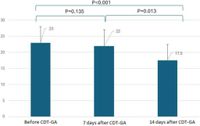A prospective study examining pediatric dental anxiety reveals significant findings for children undergoing comprehensive dental treatments under general anesthesia (CDT-GA). Conducted in 2023, this study enrolled 80 healthy children aged 3 to 10 years to explore how dental anxiety shifts before and after these treatments.
Pediatric dental anxiety is a prevalent concern, affecting children and complicating essential dental care. For many young patients, general anesthesia serves as a crucial option, particularly for those who are non-compliant due to anxiety, mental health issues, or developmental challenges. The need for effective management of this anxiety is reflected in the findings of this new study.
Prior to undergoing CDT-GA, anxiety levels were measured using the Modified Child Dental Anxiety Scale - Faces Version (MCDAS-f). This was done before the procedure, and again on the seventh and fourteenth days after the anesthesia. The results indicated a significant decrease in dental anxiety—specifically, a noteworthy reduction observed 14 days post-treatment, with p-values showcasing statistical significance (P = 0.013).
Interestingly, it was found that the anxiety levels experienced before the CDT-GA had a direct impact on post-treatment anxiety levels on both day seven and day fourteen after the procedure (P < 0.001). Other factors such as the duration of anesthesia, number of treatments performed, age, and gender were shown to have no significant effect on the anxiety levels recorded after the procedure.
Conducted at a referral hospital in Iran, this study is significant in demonstrating how carefully managing preoperative anxiety can influence the dental care outcomes for young patients. The children's average age was 62 months, with a slight female predominance (45%). The mean number of dental interventions during anesthesia was recorded at 18.3.
To alleviate anxiety prior to undergoing CDT-GA, children were administered midazolam nasally (0.3 mg/kg) approximately 15 to 20 minutes before the procedure. This practice aimed at reducing anxiety proved effective, contributing to positive outcomes during the treatment.
The implications of these findings underscore the importance of addressing preoperative anxiety in pediatric patients. It is crucial for dental practitioners to implement targeted strategies to alleviate this anxiety prior to treatment, as the study indicates that reducing pre-operative anxiety may significantly enhance postoperative experiences for children.
In conclusion, the study emphasizes that preoperative anxiety is the only significant predictor of postoperative anxiety for children undergoing CDT-GA. As anxiety levels fluctuate over time, a marked decrease in anxiety was observed by the end of the fourteen days following the treatments. Addressing preoperative anxiety presents an opportunity to improve the dental experience and outcomes, establishing a more favorable attitude towards dental care for young patients.

